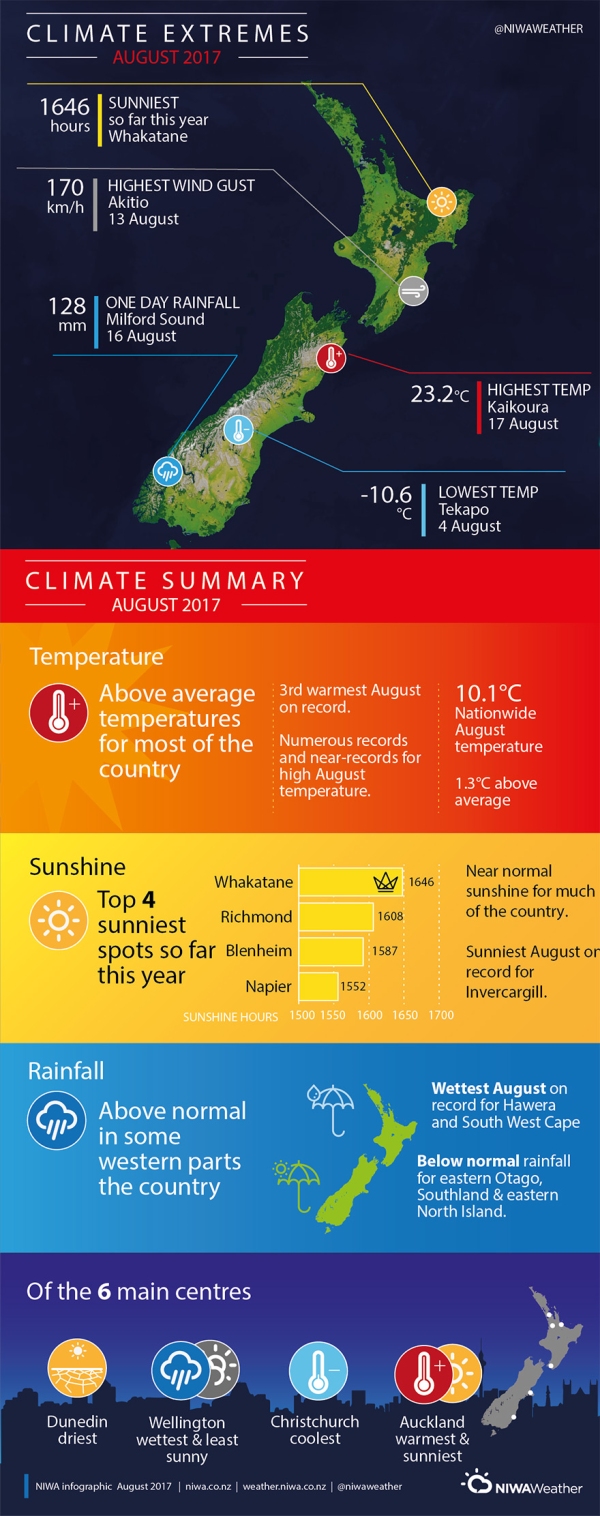A warm end to winter, wet in central and southwestern parts of both Islands, dry for much of the east.
|
Temperature |
Third-warmest August on record. Above average (+0.51°C to +1.20°C) to well above average (> +1.20°C) temperatures for almost the entire country. |
|
Rainfall |
Well above normal rainfall (> 149%) in central and western areas of the North Island, with below normal rainfall (50-79%) for the east. In the South Island, rainfall was well below normal (< 50%) in eastern Otago and Southland, but above normal (120-149%) in Fiordland, central parts of the West Coast and Canterbury, and to the very north. |
|
Sunshine |
Sunshine hours were near normal (90-109%) or above normal (110-125%) for much of the country. Below normal sunshine (75-89%) occurred in central and southern parts of the North Island, and the very northern portion of the South Island. |
|
Soil Moisture |
As at 1 September 2017, soil moisture levels were near normal for virtually the entire country. Soil moisture was slightly higher than normal in Kaikoura through western Marlborough, as well as north of Dunedin through to Oamaru. |
Overview
Overall, mean sea level pressure was lower than normal over and to the west of New Zealand during August while higher than normal mean sea level pressure occurred offshore to the east. These pressure patterns resulted in more northerly wind flows across the country, resulting in warmer than average temperatures for the time of year. Several isolated storm events brought large amounts of rain to parts of the country resulting in flooding, most notably around Christchurch and New Plymouth. See the Highlights and Extreme Events section for full details.
August sunshine hours were largely near normal to above normal for New Zealand although wetter parts of the central and southern North Island, as well as the northern tip of South Island experienced cloudier than normal conditions.
Further highlights
- The highest temperature was 23.2°C, observed at Kaikoura on 17 August.
- The lowest temperature was -10.6°C, observed at Tekapo on 4 August.
- The highest 1-day rainfall was 128 mm, recorded at Milford Sound on 16 August.
- The highest wind gust was 170 km/hr, observed at Akitio (Tararua District) on 13 August.
- Of the six main centres in August 2017, Auckland was the warmest and sunniest, Wellington was the wettest and least sunny, Christchurch was the coldest, and Dunedin was the driest.
- Of the available, regularly reporting sunshine observation sites, the sunniest four locations in 2017 so far (1 January – 31 August) are Whakatane (1646 hours), Blenheim (1608 hours), Richmond (1587 hours), and Napier (1552 hours).
Download
- August 2017 Climate Summary information [PDF 700KB]
- August 2017 Climate statistics [PDF 68KB]
Contact
Mr Chris Brandolino, Principal Scientist – Forecasting, NIWA National Climate Centre Tel. 09 375 6335

